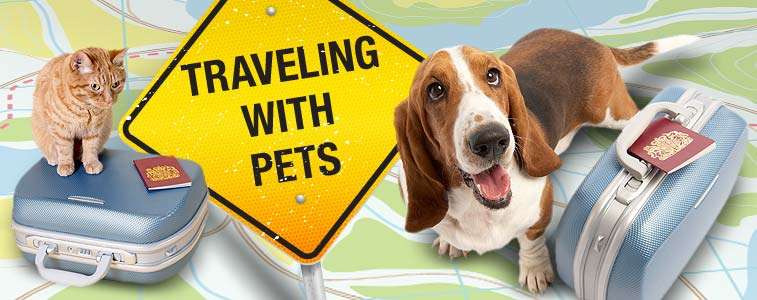Regarding vacations, it’s only natural to want to take the most treasured family members with you. In this vein, taking a dog on holiday is the most realistic option for any dog owner. However, it’s not always all fun and relaxation—sometimes, it can be a bit challenging!
While dogs can add fun, warmth, and comfort to your travels, they can also be a restrictive force and often add additional expense to a trip. Here are some insights into travelling as a dog owner.

This article will examine some of the most important things to consider when travelling with your dog.
Travelling as a dog owner. Where to go?
The first thing to consider is that staying reasonably local within the same country can make things a lot easier. Second, not all climates will be ideal for your furry friend, particularly if you’re going somewhere extremely cold or hot. Of course, you can purchase accessories to help your dog adapt. Tiny shoes, for example, can help your dog avoid getting burnt pads from walking on hot ground.

Remembering your dog’s personality is essential, as some dogs love adventure and change, whereas others get anxious and like to stay in familiar surroundings.
This is similar to humans, so consider your pet’s emotional needs when considering where to go. Think about where you are heading regarding the effect on your dog rather than where you want to go.
Navigation and Instructions
Once you’ve determined your destination, the next step is to examine the baggage regulations and restrictions that might affect your trip. For instance, if you travel abroad, some countries have particularly stringent rules, such as the UK.
Your pet will most likely need to be microchipped and have proof of a rabies vaccination. However, if you are travelling to the UK or Ireland, for instance, an additional tapeworm treatment is required.
Although the prevalence of rabies has declined in recent years, countries like Australia still have a quarantine in place, meaning your dog will have to be locked up for at least ten days without you being able to see them. This can be scary for the pet and the owner, especially if your dog is too big to fly in the cabin with you. It’s, therefore, wise to look at destinations with regulations that aren’t too strict so that you and your dog have an easy transition.
How To Travel
Regarding “how to travel,” this depends on where you are going. Of course, the car is the most convenient and comfortable option for the dog and its owner. Yet, opportunities exist for almost all types of public transport, including planes. Each type of transport has a different kind of challenge. Let’s consider a transatlantic flight, for instance.
The best option is to bring your dog with you in the cabin. The alternative is to include your dog on the same flight as you but in the hold (usually, there’s a size restriction on animals that can travel in the cabin with you). Finally, you could transport your dog separately on a cargo flight.
Most airlines have regulations regarding the size of your dog in terms of bringing them into the cabin (46 cm length x 28 cm width x 24 cm height) and a maximum weight of 8 kg.
Unfortunately, if your dog is in the cabin with you, you’re not allowed to take them out of their carry case, as they will be treated as carry-on luggage, meaning you can’t walk them up or down the aisle or have them cuddle up on your lap. This can be very upsetting and stressful, especially if your dog is in trouble.
If your dog is too big to fly in the cabin, the next option is to transport your dog as “checked baggage.” The hold’s pressure and temperature are regulated, so it’s not as grim as it sounds. However, leaving your dog unattended and having no access during the flight.

Perhaps the most pleasant yet expensive option is to arrange for your dog to fly on a specialist cargo plane. In this case, a team of employees will look after your dog. The only downside is that your dog will not arrive at the same time as you, but given the enhanced comfort of a cargo plane, i.e., a giant cage, it might be a better option.
Due to strict rabies regulations, you must use a professional cargo company when flying into some countries, such as the UK. It might be cheaper to fly to a nearby country, such as France or Belgium, and cross the English Channel by Eurotunnel or ferry. Some boat companies have kennels on the boat, whilst others insist your dog remain in the car.

Where to stay
When it comes to finding vacation rentals that allow dogs, more and more hotels, hostels, and even restaurants are changing their policies to be more dog-friendly. There seems to be a paradigm shift, particularly in rural communities. Where dogs are viewed in a similar light to children—in that well-behaved dogs are welcomed and treated very positively.
For instance, bringing your dog to a hotel has never been more convenient. Some hotels request an additional charge to cover the increased need for cleaning (e.g., to get dog hair out of the carpet), and there are websites such as Bring Fido that can help you find places to travel with your dog.

It might be worth confirming with the venue that their pet policy hasn’t changed. The last thing you want is to turn up at a nice hotel and be told, disgustingly, that you can’t bring your dog with you.
Another option is to look at Airbnb; you can filter for pet-friendly properties. Just be aware that not all dogs will get on with each other, so it’s something to consider in terms of your dog’s personality; if they are friendly and relaxed, then it shouldn’t be a problem, but if you have a nervous or aggressive dog, it could be a bit more of an issue.

A brilliant option for many people is the more traditional path of camping. The benefit of camping is that almost all campsites are dog-friendly. Your dog will be in an engaging environment that will truly feel like a vacation for them—consider the difference between staying in a fancy hotel versus in a field or forest next to a river they can swim in!
Camping can be one of the best ways to travel with your dog if you love the outdoors. Although it may not be “easy,” it is “relaxed” in the sense that you don’t have to worry about your dog’s behaviour.
Setting up your tent in the backyard and acquainting your dog with the concept of camping can be helpful. This helps them understand the boundaries and get comfortable inside a tent. This approach ensures you won’t be stressed in the middle of nowhere if your dog struggles to settle into the tent.

In short, you need to consider your travel plans from both your and your dog’s points of view.

While you might like the idea of a trip to the Bahamas, chances are your dog will not—the heat will be too high, the transportation will be too stressful, and the environment itself could be stressful, too, if there are territorial packs in the neighbourhood. Similarly, whilst you might appreciate a posh hotel, your dog will likely feel trapped.
In contrast, jumping in the car and heading somewhere in nature, sleeping under the stars with plenty of activities and freedom for your dog to explore can be a much more enriching experience for your dog… and it can be a tremendous value add to you.
There’s something about camping with a dog that significantly improves the experience. If you don’t like the idea of camping in a tent, you could always try glamping or renting a little cabin somewhere that provides you with the home comforts you need while providing your dog the value and excitement of staying in nature. It would be best to consider this from both your dog’s perspective and your own, particularly when considering long-haul travel by aeroplane.
















